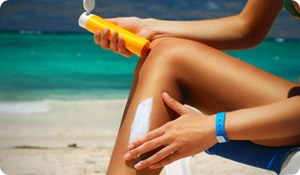
Sunscreens are an important component of overall sun protection, but SPF ratings and confusing marketing language on sunscreen packaging make it difficult to evaluate what you are purchasing. Roughly one million Americans were diagnosed with non-melanoma skin cancer in 2009. Another 69,000 were diagnosed with melanoma, which is a rarer, but more deadly, form of skin cancer.
What You Should Know
Sunscreens help protect you from the sun's damaging rays. The sun emits two kinds of rays: UVA and UVB. Most sunscreens offer protection from UVB rays, but not the more harmful UVA rays. Sunscreens are rated by SPF (sun protection factor), which is based on the minimum number of minutes you can be outside without burning. If you can stay outside for 10 minutes before you begin to burn, an SPF 10 means you can remain outside for 100 minutes before burning.
It's easy to assume that a higher SPF affords more sun protection. This is only partially true. The amount of protection does not increase proportionately to the SPF number. An SPF of 30 screens 97 percent of UVB rays; however, an SPF of 15 screens 93 percent. An SPF of 55 or higher only blocks one to two percent more sunburn rays than an SPF 30 sunscreen. Furthermore, the degree of protection a sunscreen provides also depends on your skin type, how much you apply and how often, and your activities. When you swim or sweat, you must apply sunscreen more frequently.
There is a caveat, however. Studies show that you're exposed to eight to 10 percent more sun for every 1,000 feet climb in elevation; so higher SPFs may pay off as you move further away from sea level.
Unfortunately, the Environmental Working Group's annual investigation on the safety and effectiveness of sunscreens finds two out of five either don't provide adequate protection or contain harmful ingredients.
Actions to Take
Use sunscreens labeled "broad spectrum", which blocks both UVA and UVB rays. Products that contain avobenzone (Parsol 1789), titanium oxide, zinc oxide, or mexoryl protect against UVA rays. Avoid products with oxybenzone, a hormone disrupter. Because so many people do not use enough, or improperly apply, sunscreen, the American Academy of Dermatologists now recommends a minimum SPF of 30.
Apply sunscreen 15 to 30 minutes before going outside. Reapply every two hours or immediately after swimming or sweating. You need one ounce (approximately a shot glass) of sunscreen to cover your entire body.
Check the EWG's database of 1797 sunscreen products to see which ones offer the best protection.
Sources:
National Cancer Institue. "Cancer Trends Progress Report 2009/2010 Update: Sun Protection." Web. 15 April 2010. http://progressreport.cancer.gov/doc_detail.asp?pid=1&did=2007&chid=71&coid=711&mid=
National Cancer Institute. "What you need to know about skin cancer." Web. 30 July 2009.
http://www.cancer.gov/cancertopics/wyntk/skin
Lowry, Fran. "High SPF Essential at High Altitudes to Protect Against Sun Damage." Medscape Medical News. Web. 08 March 2010. http://www.medscape.com/viewarticle/718092
Bradford, Porcia T. "Skin Cancer in Skin of Color." Dermatology Nursing 21(4) (2009): 170-77; 206. Medscape Medical News. Web. 23 November 2009. http://www.medscape.com/viewarticle/712363
Doheny, Kathleen. "New Report Finds Flaws in Sunscreen Protection, Safety." Medscape Medical News. Web. 3 July 2009. http://www.medscape.com/viewarticle/705277
American Academy of Dermatology. "Sunscreens/Sunblocks." Web. 10 November 2009.
http://www.aad.org/public/publications/pamphlets/sun_sunscreens.html
Schroeder, Sarah. "More Than a Cover Up: NCI Research to Prevent Skin Cancer." Benchmarks. Web. 1 July 2003. http://benchmarks.cancer.gov/2003/07/more-than-a-cover-up-nci-research-to-prevent-skin-cancer/
Environmental Working Group. "2009 sunscreen guide." Web.





